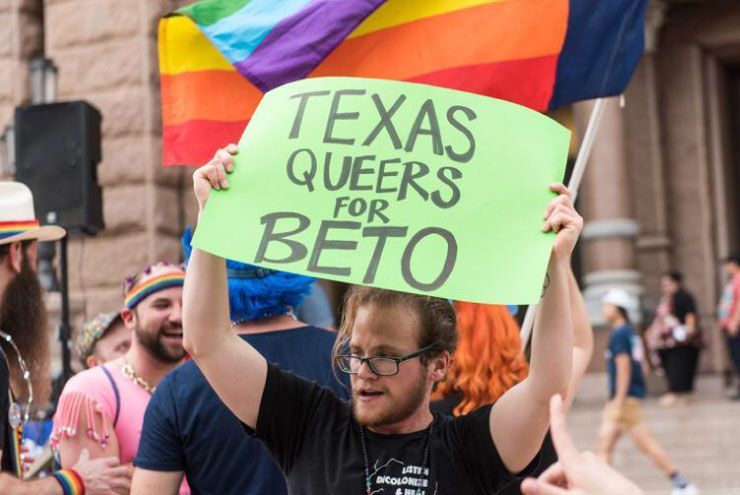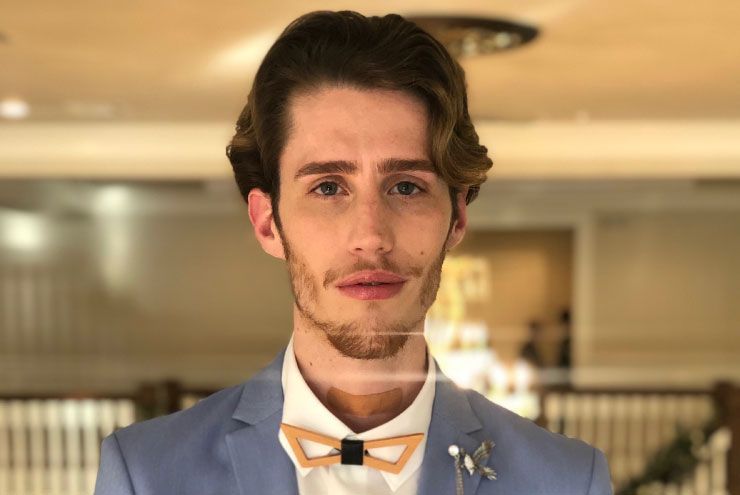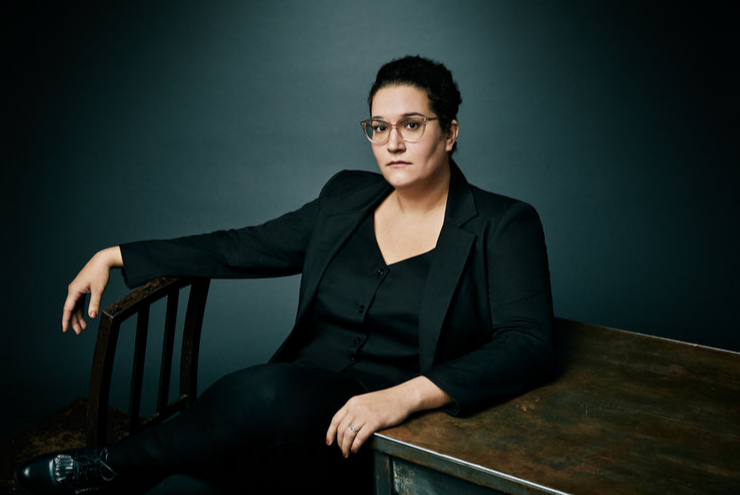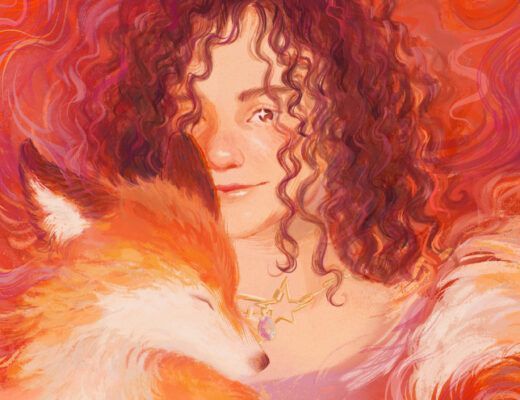By Kelly M. Marshall
At first glance, my upbringing was unremarkable. I grew up in Corpus Christi, Texas, a Padre Island beach baby. I was firmly white upper-middle class. My mother was white collar, a second-wave feminist trial attorney who carried me in her womb during her last nine months of law school. My father was blue collar, a master electrician and a newly–recovering alcoholic who likes to constantly remind me that I am an eighth-generation Texan. Our ancestors settled here from the Czech Republic/Bohemia in the late 1800s. My father’s clan and a few others are responsible for the vestiges of Czech culture that are present in the Gulf Coast and Texas Hill Country.
I was a weird kid, deeply introverted and a dreamer. I always knew I was different from most of my peers, but I didn’t quite put my finger on it until my best friend in high school seduced a kiss from me as she painted my toenails in her bedroom. Then female-identified, the kiss itself stopped time and hit me with a cosmic two-by-four of lesbian desire. Three months later, I came out as a lesbian to my mother, and she cried.
“Can’t you at least be bisexual? Then you might have a shot at a normal life! Life is going to be so hard for you!” she sobbed. It was the late ‘90s and Ellen DeGeneres was on the cusp of coming out on national television. My only reference for lesbian representation at that point was Xena: Warrior Princess, which I watched religiously.
I shrugged at her tears, nonplussed. Mentally, I was scheming the next time I could lock lips with my friend, who was swiftly turning into my girlfriend.
Amidst this awakening was a vague feeling of sameness and camaraderie with my male friends. I watched a video of myself at my girlfriend’s birthday party and thought, “I seem very boyish in my mannerisms and movements. Huh. Whatever.” I filed it away.
My parents divorced, and I moved with my mother to Smithville, Texas to finish high school. My graduating class numbered 103 people. I was the only out lesbian in my high school. I dispensed with aspiring toward good grades and settled on just graduating, surviving. There was also one gay boy who was out, and he had a rough go of it. Being harassed by the “kickers” and jocks was a daily trial for both of us.
For the uninitiated, “kickers” were the folks in high school who were involved with FFA, a school club focused on showing livestock, rodeos, and farming. They wore Wranglers, cowboy or trucker hats, and of course, Western boots. “Kickers” refers to the boots, AKA “shit-kickers.” They would grill me on my lesbianism, tell me that I was twisted and going to hell, and one straight couple in particular would periodically lean against my locker theatrically making out, then turn to me and say something along the lines of, “That’s how it’s done, dyke.”
I instinctively gravitated toward theatre, and the concentration of closeted queers created an unspoken bond between us. I devoted every ounce of spare time I had to that cadre of kids. They were the key to my survival while growing up gay in rural Texas. The rehearsals and performances created an excuse to connect, to escape, to become. Twenty years later, I’m still connected with them, and theatre still occupies a tender space in my heart.
Fast forward through the drama of my twenties in Austin, Texas, which consisted of a litany of sordid love affairs, lots of poetry and erotica, dead-end jobs at restaurants and bookstores, blackout drunk evenings, and one eight-year-long unrequited love obsession.
Halfway through my 200-hour yoga teacher training, I found myself staring in the mirror as I did Virabihdrasana II, also known as Warrior II pose.
The pose perplexed me. I would stand in front of the mirror and do this pose repeatedly, brow furrowed and puzzling over alignment. Left foot forward, right foot back. Feet placed perpendicular. Hips externally rotated. Legs engaged and coiled muscle. Neutral pelvis, ribcage contained. When it came to my chest, I hesitated. Supinate the palms. Breath into collarbones. Shoulder blades engaged together a bit and down.
What was it? What was wrong?
I stared down at my 36DD breasts.
Thus far, I’d cultivated a live-and-let-live relationship with my boobs, mostly because other people really liked them. It’s hard to dislike something about yourself that other people glorify.
But in this moment, it became really clear how disconnected I felt from my breasts. They felt like they were wearing me, like an ugly hat or a too-tight pair of pants I just could not rock with full confidence.
And beyond that, I didn’t want them. Not even a little bit. And for the first time in my life, I was honest with myself about that.
Tears started streaming down my face. My breasts were my tenuous connection to womanhood, to owning a female body, and to my lesbian identity. I always joked that internally, I felt indifferent in my gender—that I would have been just as happy born in a male body as a female one.
In this moment, I realized that wasn’t entirely true.
I released the pose and walked out of the studio, sitting down heavily at one of the picnic tables outside.
I couldn’t stop crying. I knew that I was at the beginning of something huge and unwanted. Tension released from muscles in my body that I didn’t even know I had as I continued to sob, allowing and accepting a truth I could no longer ignore: I am transgender.
I got engaged around the same time I started testosterone. I waited forever and ever before I began HRT, due to fear and rampant misandry. I didn’t want to become a man—something I didn’t understand and viewed as dangerous and foreign. My concept of gender transition, at the time, was very binary; you left one gender to become the other. I was deeply depressed and suicidal. Finally, my fiancée put her foot down, as I stood outside our house and ranted in the street madly about suicide via riding my bicycle into traffic.
“We’re done with this, Kelly. Call the doctor. We’re getting you on antidepressants and testosterone, starting tomorrow,” she commanded.
And so, I did.
Testosterone was not a silver bullet. But, it quieted the anxious voices in my head. It dulled my intuition and creativity. It streamlined my thought process. It amplified my sex drive. And it changed my appearance.

“Choosing to be openly non-binary these days is a radical act of defiance against the gender binary.”
-Kelly M. Marshall
In the South, there exists a serious clinging to gendered honorifics like “sir” and “ma’am.” These words became the bane of my existence. Every day, my self-worth was measured and weighed by the utterance of these words from complete strangers. After a while, I realized that I had no control over how other people perceived me or my gender. On the phone, it was and continues to be “ma’am.” In person, it vacillated until it didn’t. And even now, I resist the designation “sir.” It evokes an unpleasant somersault in my stomach of erasure, of not being seen. That reaction brought me to my most recent realization: I’m not a man, strictly speaking. I’m non-binary. I feel most comfortable with they/them pronouns.
My attachment to they/them is partly political and partly personal. Choosing to be openly non-binary these days is a radical act of defiance against the gender binary—especially in the South, where things are much more old-fashioned, traditional, and heteronormative-oriented.
Most people who aren’t versed—at least in a cursory way—in queer culture don’t “get” the use of they/them pronouns. And right now, for me, that’s fine. I don’t usually have the emotional energy to educate them anyway. I’ll abide he/him with minimal resentment. I have that privilege. However, if I’m invested in a relationship of transparency with someone, I’ll disclose and educate them on my non-binary status. I’m still figuring out how to present as non-binary in a more expressive (and safe) way.
I’m lucky to live in Austin. Here, I’m encouraged to be a total queerdo, and enthusiastically accepted and supported as such. I’ve purposely chosen to remain in Austin for most of my adult life because of this familiar and insular queer community, which feels more progressive and accepting than most. The Austin queer community is quickly becoming legend as a “queer oasis,” a San Francisco Bay Area vibe in the Deep South. In some ways, it is. But it’s small, an incestuous family. The L Word chart-level interconnected. Maybe it’s that way everywhere. I don’t know; Austin has been my only adult home, so far.
So here we are, dear reader. A non-binary and transgender self-employed yoga therapist, massage therapist, and mindfulness coach who also writes poetry, fiction, non-fiction, and gripping journalism for our dear queer Spectrum South. It’s a pleasure and honor to meet you and share my passion and writing with you, fam.








Autumn Rendall
June 14, 2018 at 5:51 PMA powerful experience conveyed with excellent, honest writing. An absolute pleasure to read!